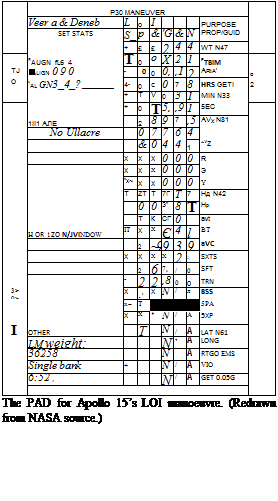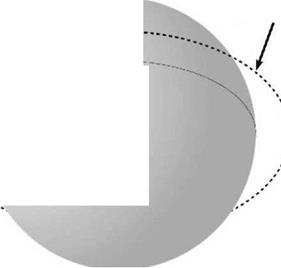THE LOI FAD: I I ISX’I MAGIC
While the crew7 conducted their checks, engineers on Earth carefully measured the effect of both the final mid-course correction and, if appropriate, the jettisoning of the SIM bay door. From this, FIDO calculated the definitive LOI-1 burn. All the information associated with the burn was written onto a pad of no-carbon-requircd paper that allowed six copies to be made at once. The top layer w;as written using a red ballpoint pen in order to help to distinguish what was to be read to the crew7.
This list, referred to as a PAD (pre-advisory data), w’as read carefully by Capcom over the air,7ground communication circuit and copied by one of the crew7, usually the LMP. onto an identical form. Immediately afterwards, it was all read back to Earth w’here several flight controllers checked it to confirm that its contents had been correctly copied dowm. Much of the information in the PAD would later be entered
manually into the computer as the first stage of preparation for the automatic control of the burn.
 It seems like a woefully low-tech way to relay data to the spacecraft by using voice, and although there had been some consideration of adding a teleprinter to an already crammed cabin, the idea was shelved in view of the limited space, the weight of the apparatus and the tight schedule imposed on the programme by Kennedy’s challenge. Anyway, the use of voice, paper and pen is a wonderfully lightweight method of data transfer. The solution didn’t have to be elegant. It just had to work.
It seems like a woefully low-tech way to relay data to the spacecraft by using voice, and although there had been some consideration of adding a teleprinter to an already crammed cabin, the idea was shelved in view of the limited space, the weight of the apparatus and the tight schedule imposed on the programme by Kennedy’s challenge. Anyway, the use of voice, paper and pen is a wonderfully lightweight method of data transfer. The solution didn’t have to be elegant. It just had to work.
The PAD for the Apollo 15 lunar orbit insertion manoeuvre was read up to Jim Irwin in the command module Endeavour by scientist/ astronaut Karl Henize.
"Okay. LOI, SPS/G&N; 66244; plus 121, minus 012; 078314591.”
The PAD was little more than a list of numbers that were almost indecipherable to the uninformed ear.
“Minus 28975, minus 07764, minus 00441; all zips for roll, all zips for pitch, all zips for yaw.”
As well as the impenetrable numbers, the jargon-rich language owed much to the military aviation background that most of its participants, both crew and flight controllers knew well.
“01696, plus 00584, 30001, 641, 29939; 25, 2671, 228; the rest is NA.” Henize read out these numbers in strict order from the top copy of the form, with each digit occupying its own box. On board Endeavour, Irwin wrote the digits onto his form, one in each box. Months of training and simulation meant that in many cases, the crews knew what kind of numbers they should expect, which helped to trap errors. The PAD finished with a series of comments related to the burn.
“Set stars are Vega and Deneb; 264, 090, 349. No ullage; LM weight, 36258. Single-bank burn time is 6 plus 52; and just a reminder that, if bank В doesn’t burn,
we are expecting you to go into lunar orbit on bank A.” This latter comment was directly related to the electrical short in Endeavours SPS circuitry.
Apollo thrived because, when dealing with the hostile, unforgiving space environment, particularly in the vicinity of the Moon, its people worked through the technical and operational aspects of the task with great care. Hvery item on this PAD was well defined and the procedures for passing such lile-or-death information to its recipients were strictly adhered to. The following puts meaning to the numbers and phrases.
LOI, SPS/G&N The first two items stated the purpose of the PAD and the systems that would be used to achieve the manoeuvre that it described. In this ease, the PAD is for the lunar orbit insertion burn that would place Apollo 15 into its initial orbit around the Moon. The burn was carried out by the SPS engine and associated equipment under the control of Endeavour’s primary guidance and navigation system.
66244 – In its calculations, the computer needed to know what mass the engine had to push against. This was in two parts, the CSM and the LM. Since the PAD form only had space for the CSM mass, the LM mass was given later. It is an interesting aside that the people at NASA were still using the term ‘weight’ when, strictly speaking, they should have been using the term ‘mass’. Mass is a measure of the amount of matter an object has. and in modern times the standard unit of mass is the kilogram. Weight is a measure of the force exerted by the mass on whatever is supporting it, which varies according to the gravity field it is in. At this point, the Apollo CSM was weightless though its mass was just over 30,000 kilograms (66,244 pounds as given in the PAD). This figure was determined by pre-flight measurements, and by carefully accounting for consumables on board the spacecraft, including the jettisoned panel.
Next were two three-figure values with signs – phis 121 and minus 012. These were angles, measured in hundredths of a degree, and with their decimal points, could be written as — 1.2Г1. and 0.12′. Known as the pitch and yaw trim, they were the angles to which the crew had to swivel the main engine’s nozzle so that, at the start of the burn, its thrust would act through the spacecraft’s centre of mass. Throughout the progress of the flight, the position of the centre of mass changed as propellants were used up, the lunar module departed and redocked, and as the tnoonrocks were transferred to the command module. All this shifting of mass was carefully accounted for by mission control so that the spacecraft’s flight characteristics would be known w’hen planning a manoeuvre. Once the engine was running, the spacecraft’s centre of mass would change as propellant was consumed. The G&N system could sense these shifts and would steer the nozzle as required in order to steady the spacecraft throughout a long burn.
The large nine-digit number – 078314591 – represented the lime of ignition, normally referred to as ‘Tig’, down to hundredths of a second as measured against the ground elapsed time (GET) clock. In this case, ignition w:as to occur at 78 hours. 31 minutes. 45.91 seconds after launch. Although GET was notionally measured from the moment of lift-off from Earth, in cases where the launch was slightly delayed the GET could be adjusted during the flight so that subsequent event times
would match their place in the flight plan – this was done, for example, on Apollo 14.
Change in velocity: delta-v and frames of reference
The main purpose of the LOI burn was to slow the spacecraft down by a desired amount. This change in velocity is really a vector quantity because its direction is as important as its magnitude. Known within the industry as delta-v, it is normally resolved into three components (v, у and z) which were given by the next three numbers in Henize’s list – minus 28975, minus 07764 and minus 00441. Such was the primitive nature of the Apollo computer that there was no provision in it for entering or displaying a decimal point. Instead, the position of the decimal point was fixed in the programming and on the form. Everyone associated with the machine knew where the decimal point was in any particular context. Here, 28975 simply meant that the burn was for a change in velocity along that axis (but, being negative, in the opposite sense to the direction of the axis) of 2,897.5 feet per second.
So what about these three axes? By now it should be clear that coordinate systems were, and are, ubiquitous in spaceflight, and become especially important when dealing with engine burns. The firing of an engine in space results in a change of velocity and it is necessary to define the direction of that change in relation to a frame of reference; a known set of Cartesian coordinates against which it can be plotted. We can use any frame of reference we like but it is customary to use one that makes the calculations easier, and the one that is generally favoured is called local verticalj local horizontal (LVLH).
– „е
" – – SctiCf,/
‘*’■ ^
Spacecraft
![]()



 position
position
This frame of reference is constructed relative to a line drawn from the spacecraft to the centre of the body it is orbiting, or whose gravitational sphere of influence it has entered. Imagine a point where this line intersects the planet’s surface. We can further imagine a flat plane at this point parallel to the horizontal. Obviously, as the spacecraft moves around the planet, the absolute orientation of this plane keeps changing but it provides a useful reference for orbital velocity computation. In this arrangement, the — z axis points towards the planetary centre, the —л – axis is in the direction of orbital motion parallel to the local horizontal and the + v axis is perpendicular to the orbital plane.
With this, we can make more sense of the velocity components given in the PAD. The large negative figure for the. x component. 2.897.5 feet per second, meant that the burn was largely retrograde, against the spacecraft’s motion, which is exactly what would be expected, given that they were trying to lose speed. The figure for v. 776.4 feet per second, meant that the spacecraft was being pushed sideways as part of the process of ensuring that it ended up in the correct orbital plane for the landing site. The figure for z, -44.1 feet per second, was small in comparison and was away from the Moon’s centre. Converted to metric units, these velocities were expressed as -883.2, -236.6 and -13.4 metres per second.
“All zips for roll, all zips for pitch, all zips for yaw" Again we have to deal with frames of reference for these three numbers, all of which are zero. However, whereas delta-v used local vertical/local horizontal as described above, these numbers were given with respect to the guidance platform, itself aligned to our old friend, the current REFSMMAT. For every burn, mission control gave the crew a set of three angles that represented the attitude of the spacecraft in terms of roll, pitch and yaw directions and these were always stated with respect to the current RHFSMMAT. But since the platform’s orientation had been aligned to match the spacecraft’s calculated orientation for the burn – the so-called LOI RHFSMMAT – then the attitude angles for this burn were necessarily all zeros, or ‘zips’ as Ilenize put it. This arrangement meant that the FDAI (flight director attitude indicator) or ‘8-ball" in front of the crew showed zero in all three axes. This provided an easy means of monitoring the direction in which the spacecraft was pointing, in case the crew had to take manual control.










